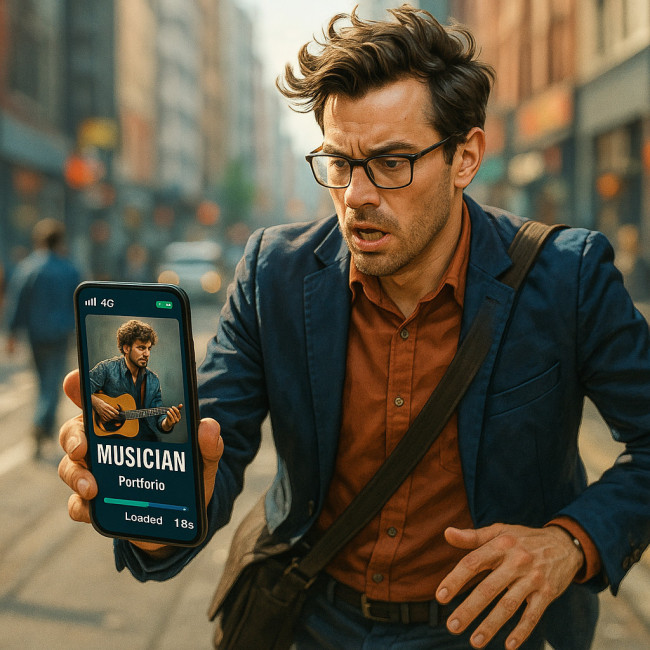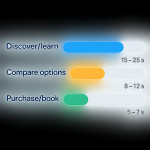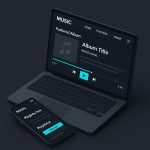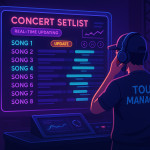Designing a musician portfolio that loads in under 2 seconds on mobile networks
Your portfolio is often opened on a shaky 4G signal while a booker rushes between meetings. If the first track, image or bio line is not visible in two seconds, you risk an instant swipe-away. Follow this step-by-step guide to build a lightning-fast, visually rich musician website that converts visitors into confirmed gigs.
Why the 2-second benchmark is non-negotiable

Google's mobile research shows that bounce probability jumps dramatically after the two-second mark. Musicians compete with social feeds and streaming apps; every additional second costs you attention and revenue. This delay doesn't just lose impatient fans; it erodes your brand reputation, lowers conversion rates on merch sales, and signals to search algorithms that your site is unworthy of top placements. In an era of nanosecond attention spans and endless scrolling, speed is not a flashy add-on—it's the entry ticket to the gig economy.
Source : Google Mobile Benchmark Report
Audit your current speed in five minutes
- Run PageSpeed Insights on both 4G and 3G simulations.
- Note Largest Contentful Paint (LCP); aim <2 s.
- Check Total Blocking Time for heavyweight scripts.
- Open Chrome DevTools → Lighthouse → “Simulated Slow 4G” to validate real-world times.
- Create a simple spreadsheet to log before/after metrics.
Key levers to reach sub-2-second loads
1. Host & cache like a pro
Select a high-performance host with edge nodes near your audience and enable HTTP/2 or HTTP/3. Add a CDN layer for global tours.
2. Compress visuals without dulling your vibe
Convert hero images to WebP or AVIF, limit resolution to 1600 px wide, and lazy-load below-the-fold galleries. Deep dive into visual tactics in this guide on optimising images.
| Asset | Before | After | Gain |
|---|---|---|---|
| Homepage hero photo | 2.3 MB JPEG | 210 KB WebP | -91% |
| EP cover art | 1.1 MB PNG | 90 KB AVIF | -92% |
| B-roll video thumbnail | 900 KB JPG | 60 KB WebP | -93% |
3. Stream audio & video smartly
- Embed tracks via responsive players that load after user interaction.
- Use poster images for videos and defer the iframe until clicked.
- Store heavy media on a dedicated streaming CDN.
4. Keep third-party scripts on a short leash
Every ticket-widget or analytics tag adds kilobytes. Audit with the Coverage tab and remove anything not mission-critical. Where possible, self-host fonts and critical JS.
5. Code split & minify
Bundle CSS with PurgeCSS to remove unused declarations. Split JS per page so the tour calendar doesn't block your bio page.
6. Build mobile-first
Start with a 360 px layout, progressive enhancement, and CSS clamp() for fluid typography. For more screen-specific advice, read mobile-first portfolio design tweaks.
Portfolio elements musicians can't live without—done light
Musician sites carry unique weight: audio previews, setlists, press kits. Here's how to keep them lean:
- Audio teasers: 30-second MP3 at 128 kbps instead of full WAV.
- Setlists: Plain HTML lists auto-pulled via Fetch API, not embedded PDFs.
- Press quotes: Text + 72 dpi logos, never full-resolution scans.
- Showreel: Deliver in H.265 or VP9 and preload only the first five seconds. See this showreel optimisation tutorial.
Case study: from 5.6 s to 1.8 s
Indie artist Luna Echo had a portfolio weighed down by 15 MB of images and auto-playing video. After converting visuals, deferring embeds and replacing Google Fonts with system UI, the mobile load time dropped to 1.8 seconds. Booking inquiries rose by 27% in the following month.
Speed & SEO work together
Google's Core Web Vitals are ranking factors. Combine speed wins with structured data, internal linking and quality backlinks to dominate search results. For a full musician-specific checklist, bookmark our 2025 SEO checklist for musicians.
Quick-fire implementation checklist
- Pick a fast, SSL-enabled host with a CDN.
- Set performance budgets (HTML <30 KB, CSS <50 KB, JS <150 KB).
- Convert images to next-gen formats and lazy-load.
- Replace auto-play media with click-to-load.
- Eliminate blocking third-party scripts.
- Audit with Lighthouse after each deployment.
- Retest monthly and adjust as content grows.
FAQ
- Do I need a developer to hit the 2-second goal?
- No. Modern page builders allow code splitting and image compression plugins. A developer accelerates complex tweaks but is not mandatory.
- Can I keep high-resolution photos for press?
- Yes—store them in a hidden “Press Kit” folder or a cloud drive link, not on the landing page.
- Will disabling autoplay reduce engagement?
- Tests show users prefer control. Click-to-play keeps speed high and avoids sudden sound in quiet environments.
- How often should I audit speed?
- After any content update and at least once per quarter.
- Which metric matters most for SEO?
- Largest Contentful Paint. Keep it under 2 seconds on mobile.
Mini-Quiz: Test your speed savvy
Next steps
Ready to impress bookers at first tap? Browse new musician portfolios optimised for speed and see how your site compares. Implement one optimisation per day, retest weekly, and watch your inbox fill with gig requests.
Want more conversion tactics? Explore how social proof turns visits into bookings without slowing your load time.











